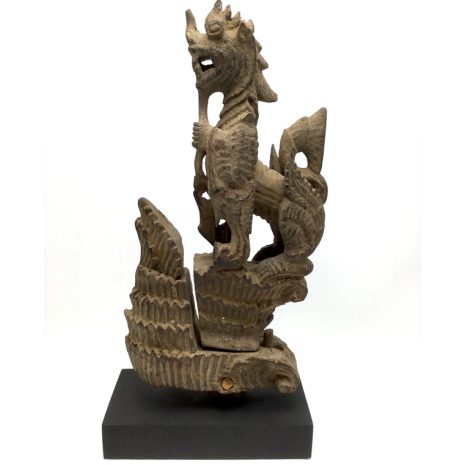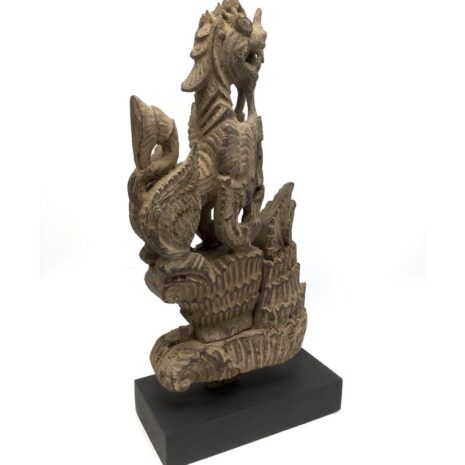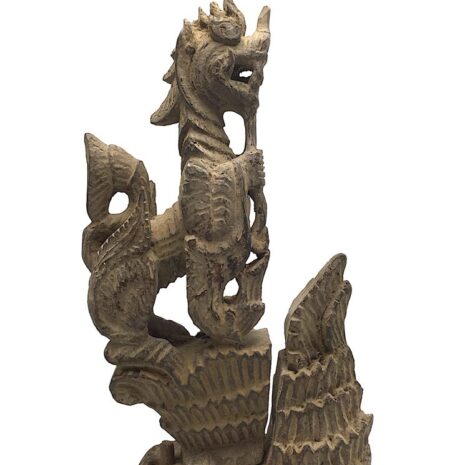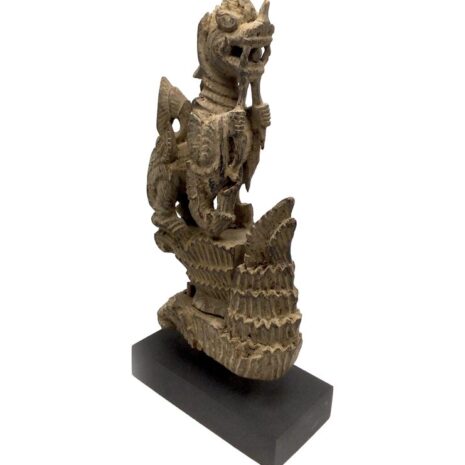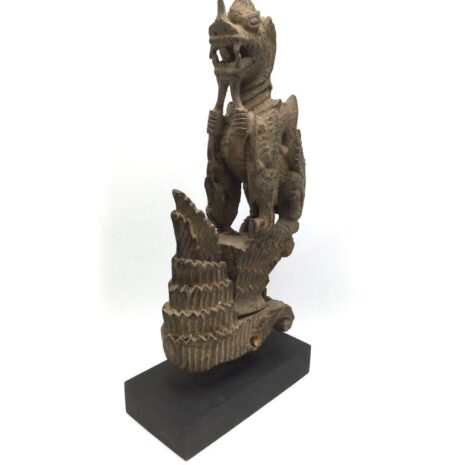Antique Lion (Chinthe) Ox Cart Ornament, Burma/Myanmar (11306FSE) $325
$325.00
H: 14.5” W: 17.75” D: 3.375” | FREE SHIPPING WITHIN CONTINENTAL U.S.!
Finely carved figures were attached to ox cart yokes to protect farmers from malevolent spirits who inhabited all seen/unseen sectors of their world. . This beautifully carved ox cart yolk image is a chinthe, a mythical Burmese lion/dragon creature commonly decorating many everyday items. A propitious spiritual and protective guardian, the animalsymbolizes power, courage, and strength. This carving displays the common traits of a lions with a long face, large eyes, a long sharp nose, a lion-like beard, and a flame-like shape on the top of his head. Masterfully carved with careful attention to details, see the deeply incised hairs that cover his body. The 2-part piece is held together with a wooden plug. Though for daily use, Burmese craftsmen created beautiful objects and finished them with the best materials they could afford.
Description
Oxen/bullocks and their carts were the primary means in Burma/Myanmar for plowing, hauling or transportation. Inexpensive and adaptable to any terrain, they were used to tend fields and carry goods, agricultural products, lumber, and people. Two or four-wheeled carts were pulled by one or a pair of oxen that were hitched to the cart by a special chain or rope attached to a wooden yoke, the wooden bar between and securing a pair of oxen that allowed drivers to pull them in a tandem pair. In Burma, Buddhists and animists believed mythical creatures and spirits effected all parts of daily life and farmers thought mythical beings could be positive or negative and required the presence of guardian figures to propitiate them to protect farmers, their crops, and their world. So, oxcart yokes were surmounted with masterfully carved guardian animal and figural images to protect the farmer and his family. A mystical Chinthe (part lion/bull) was among the most common figures depicted and \pairs often guard the entrance of Burmese pagodas and temples. Their imposing and more frightful appearance was probably inspired by native Burmese mythology and artistic traditions. Although Burma is a decidedly Buddhist country, its past was steeped in animism and shamanism held the belief that objects, places, and creatures all possess a distinct spiritual essence that could influence human life, and deserved worship and offerings to bring positive energy and keep malevolent spirits at bay.
Sources
Matthew Laird Acred, editor for Åsisbiz, “Bullock Carts of Myanmar “http://en.wikipedia.org/wiki/Bullock_carts
Fredrick W Bunce, A Dictionary of Buddhist and Hindu Iconography, New Delhi, D.K Printworld, 2001
Facts and Details Contributors, “Nats (spirits) and Animism in Myanmar, in facts and details,” http://factsanddetails.com/
Philadelphia Museum of Art, “Temple Lion (Chinthe)”, https://philamuseum.org/collection/object/277507
U. Aye Myint, My “Country Myanmar, Animals and Birds” s, Goldenland Pages http://tourism.goldenlandpages.com/articles/80-animals-and-birds.html
Additional information
| Place of Origin | Burma/Myanmar |
|---|---|
| Period | Antique (1200-1920) |
| Materials and Technique | Wood |
| Dimensions (inches) | Ht: 14.5" W: 7" D: 2.5” On stand: Ht: 14.5” W: 17.78” D: 3.375” |
| Dimensions (metric) | Ht: 36.83cm W: 17.78cm D: 6.35cm On stand: Ht: 36.83cm W: 17.78cm D: 8.5725cm |
| Weight | 2 lbs 8oz |
| Condition | Good condition, see description |
| Item Number | 11306-FSE |
| Shipping Box Size | |
| Date | 1910-1930 |

